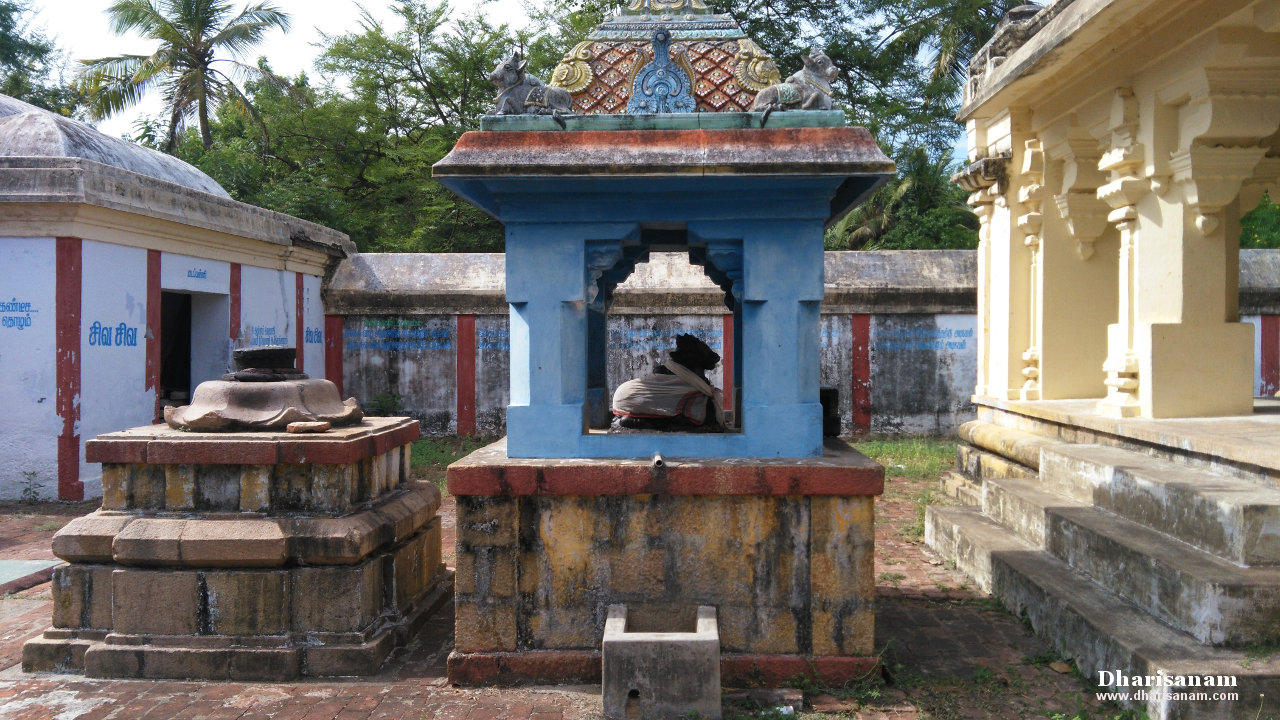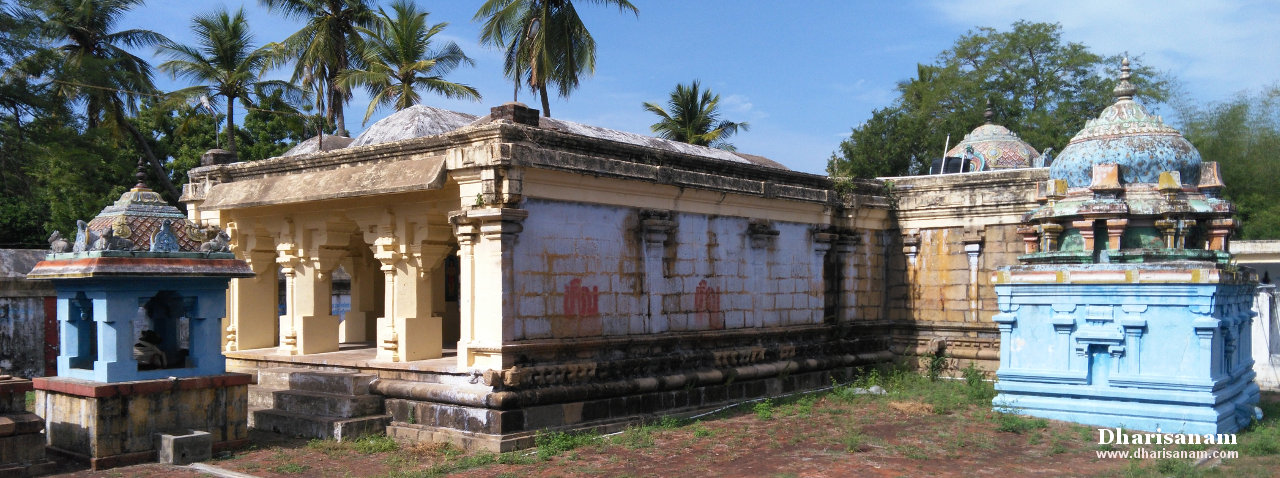Visited on: 22nd September, 2018.
Location
Thiruppanaiyur is located at a distance of about 12 kms from Thiruvarur on the Thiruvarur to Mayiladuthurai (via Andippanthal- Sannanallur-Peralam) route. Take the diversion road from this temple’s arch after Sannanallur and proceed further for about 1.5 kms to reach this temple.
From Andipanthal, cross the Putharu railway crossing and travel further for about 3 kms to reach Panayur.
Other Devara Paadal Petra Shiva Sthalams near this place are –
Nannilam, Thiru Kondeecharam, Thiru Marugal, Thiru Virkudi, Thiru Chengattangudi, Thiruppayatrur, Ramanatheecharam, Sree Vanchiyam, Thiru Pukalur, Thiru Pukalur Varthamaneecharam and Thiru Chathamangai.
General Information
| Moolavar | Sri Soundareswarar, Sri Thalavaneswarar, Sri Azhakiya Nathar |
| Ambal | Sri Brahan Nayaki, Sri Periya Nayaki |
| Theertham (Holy water) | Amirtha Pushkarni, Parasara Theertham, Thirumakal Theertham |
| Sthala Vriksham (Sacred Tree) | Palm tree |
| Pathigam (Hymn) rendered by | Saint Thirugnanasambanthar, Saint Sundaramurthy (Sundarar). |
- This is one of the 276 Devara Paadal Petra Shiva Sthalams and 73rd Shiva Sthalam on the Southern bank of the river Cauvery in Chozha Nadu (Thenkarai).
- Lord Shiva in this temple is a Swayambumurthi (self-manifested).
- This east facing temple’s main tower is not tiered. In fact, the tower itself is very small. In place of the Gopuram, there is a beautiful sculpture depicting Lord Shiva and Goddess Parvathy.
- This temple has two corridors and it does not have a flag post “Dwajasthambam”.
- The great Chola King Karikalan lived in this place in his childhood.
- The last consecration ceremony (Maha Kumbabishekam) took place on 26.08.1973.
History of the Temple
The historical name of this place is Thalavanam and the temple is known as Thalavaneswaram (“Thalam” means palm tree).
Of the 276 Paadal Petra Shivasthalams, very few temples have Palm tree (Panai) as their Sthala Viruksham. This temple is one of them. The other temples having this sthala viruksham are - Thiru Panaiyur, Thiru Vanparthan Panankattur, Thiru Puravaar Panankattur, Thiru Cheyyar, Thiru Mazhapadi, Thiru Valampuram and Thiruppanandal.
According to history, the great Chola King Karikalan grew up in this temple and lived here for around 10 years so that he could be shielded from his enemies. Karikalan was born after his father King Ilamchetchenni was killed by his enemies. After his father’s death, Karikalan and his mother were sent to this temple by his maternal uncle, Irumbidar Thalaiyar who was a Sangam era poet. Irumbidar Thalaiyar did so to ensure that the boy could be raised in peace.
At this temple, Karikalan’s mother prayed to the lord asking him to protect them from their enemies. It is believed that Lord Vinayakar here started protecting them. When Karikalan attained the age of 13, with his uncle’s help, he fought and regained his kingdom. It is believed that when the Chola ministers sent a state elephant to look for the prince, the elephant found Karikalan and garlanded him.
At the entrance of this temple, there is an idol of Vinayakar called “Thunai Iruntha Vinayagar” (“thunai” means escort, “iruntha” means side by in Tamil).
There are about 14 stone inscriptions in this temple which date back to the periods of Chola king Kulothungan-I, Sundara Pandiyan, Parakirama Pandiyan, Rajathi Rajan-I and Rajarajan II.
In these inscriptions, the lord is mentioned as Panaiyadiyappan and Panangattiraivan. It is also mentioned that this temple was built in granite in the early 11th century. The village around this temple is referred to as Rajendra Cholap Panaiyur.
This temple is under the administrative control of the Hindu Religious and Charitable Endowments Department of Government of Tamil Nadu (HR&CE).



Legend
The main Shivalingam here is believed to have been installed and worshiped by Sage Parasarar. The lord is praised as “Sri Thalavaneswarar” (“Thalam” means palm tree).
Another legend is that when Saint Sundaramurthy Nayanar was at the entrance to this village, Lord Shiva blessed him by showing the saint a vision of his cosmic dance. There is a place near this temple called “Manikka Nachiyar Thittu”. Here there is a tank called “Santhitha Theertham” which symbolises the meeting of Lord Shiva and the Nayanar (“santhitha” means met in Tamil). In his hymn, Saint Sundaramurthy Nayanar has mentioned about the lord’s dance darshan to him.
It is believed that Goddess Mahalakshmi, Sage Parasarar, Saptha Rishis (Kausikar, Kasyabar, Bharadwajar, Gauthamar, Agasthiyar, Athiri and Birugu), Saint Thirugnanasambanthar and Saint Sundaramurthy Nayanar and Chola kings Musukunda Chakravarthy and Karikalan have worshiped the lord here.
Deities in the temple
Other than the shrines of Lord Shiva and Goddess Parvathy, shrines and idols of Vinayakar, Murugan with his consorts, Mahalakshmi, Chandikeswarar, Nalvar,
Iyappan, “Karikal Cholanukku Thunai iruntha Vinayakar”, Bairavar, Suryan, Chandran, Navagraham, “Matruraitha Vinayakar” and Chandikeswarar can be seen in the corridors.
In the “koshtam” (place surrounding the sanctum sanctorum), idols of Narthana Vinayakar, Sage Parasarar, Dakshinamurthy, Mahavishnu, Brahma and Durgai can be seen.
Shivalingams worshiped by the Saptha Rishis can be seen in the corridor.
There is a separate shrine for Lord Thalavaneeswarar (Sri Panangatteeswarar) in the corridor.











Salient Features
In this temple there are two palm trees (Sthala Viruksham) – one male and the other one female. It is believed that these trees have grown by themselves without any seed. Similar to plantain, it is believed that new trees came up in place of the older ones.
It is believed that Sage Parasarar dropped a small portion of the celestial nectar, Amirtham, into the temple’s pond and hence this pond is called “Amirtha Pushkarini”.There is a Vinayakar in the Thiruvarur temple called “Matru Uraitha Vinayagar” which is connected to Saint Sundararamurthy Nayanar’s legend. In this temple also, there is a Vinayakar by the same name and this Vinayakar can be seen in the corridor.
This temple is considered to be significant for its three important attributes – Moorthy, Sthalam and Theertham - glory of Lord, sacredness of the land and the auspicious temple tank.
There are a couple of paintings in the main hall which depicting this temple’s legend such as Karikala Cholan’s early childhood here and Lord Shiva of this temple granting his darshan to Saptha Rishis and Saint Sundararamurthy Nayanar.
The front hall (Mandapam) of this temple is designed to look like the forehead of a bat (“Vovval Nethi Mandapam”). This looks very beautiful.
There is a pillar in the main hall that has a relief of Lord Karkadeswarar (Lord Shiva being worshiped by a crab).
Greatness of this temple
Devotees seeking for transfer or promotion in their workplace can worship the lord here.
Devotees also believe that by worshiping the lord here, obstacles from their marriage proposals will be removed.




Important Festivals
Some of the important festivals celebrated in this temple are –
Vinayakar Chaturthi in the Tamil month of Aavani (Aug-Sept),
Navarathri in the Tamil month of Purattasi (Sept-Oct),
Skanda Shashti and Annabishekam in the Tamil month of Aippasi (Oct–Nov),
Thiru Karthikai in the Tamil month of Karthikai (Nov-Dec),
Makara Sankranthi in the Tamil month of Thai (Jan-Feb),
Shivrathri in the Tamil month of Masi (Feb-Mar) and
Panguni Uthiram in the Tamil month of Panguni (Mar-Apr).
Pradosham is also observed regularly.
Temple Timings
From 07:00 AM to 12:00 Noon and from 04:30 PM to 08:00 PM.
Temple Address
Sri Soundareswarar Temple,
Thiruppanaiyur Post,
Sanna Nallur Via,
Nannilam Taluk,
Thiruvarur District,
Tamil Nadu – 609 504.
Tele: +91 - 4366- 237 007.
This temple’s priest, Sri Kalyanasundara Gurukkal can be contacted at +91 - 99659 81574 and 99422 81758.







Pathigam (Hymn) with English transliteration and Tamil meaning.
Saint Sundaramurthy Nayanar visited this temple and sang this Pathigam.
Devotees visiting this temple should make it a practice to recite this Pathigam.
Pathigam No.7.087
மாடமாளிகை கோபுரத்தொடு மண்டபம்வள ரும்வளர்பொழில்
பாடல் வண்டறையும் பழனத் திருப்பனையூர்த்
தோடுபெய்தொரு காதினிற்குழை தூங்கத்தொண்டர்கள் துள்ளிப்பாடநின் றாடு மாறுவல்லார் அவரே அழகியரே.
“Māṭamāḷikai kōpuraththoṭu maṇṭapamvaḷa rumvaḷarpozhil
pāṭal vaṇṭaṟaiyum pazhaṉath thiruppaṉaiyūrth
thōṭupeythoru kāthiṉiṟkuzhai thūṅkaththoṇṭarkaḷ
thuḷḷippāṭaniṉ tṟāṭu māṟuvallār avarē azhakiyarē”.
உயர்ந்த மேல்மாடங்களும், சிறந்த மாளிகைகளும், கோபுரங்களும், மண்டபங்களும் நாளும் நாளும் பெருகுகின்ற, ஓங்கி வளர்கின்ற சோலைகளில் இசைபாடுதலை யுடைய வண்டுகள் ஒலிக்கின்ற, நல்ல வயல்களையுடைய திருப்பனையூரில் எழுந்தருளியிருக்கின்ற, ஒருகாதிற் குழை தூங்க, மறறொரு காதினில் தோட்டினை இட்டு, அடியார்கள் ஆடிப்பாட நின்று ஆடுமாறு வல்லவராகிய அவரே, யாவரினும் மிக்க அழகுடையவர்.
நாறுசெங்கழு நீர்மலர் நல்லமல்லிகை சண்பகத்தொடு
சேறுசெய் கழனிப் பழனத் திருப்பனையூர்
நீறுபூசிநெய் யாடிதன்னை நினைப்பவர்தம் மனத்தனாகிநின்
றாறு சூடவல்லார் அவரே அழகியரே.
“Nāṟucseṅkazhu nīrmalar nallamallikai saṇpakaththoṭu
sēṟusey kazhaṉip pazhaṉath thiruppaṉaiyūr
nīṟupūsiney yāṭithaṉṉai niṉaippavartham maṉaththaṉākiniṉ
tṟāṟu chūṭavallār avarē azhakiyarē”.
மணம் வீசுகின்ற செங்கழுநீர் மலரையும், நல்ல மல்லிகை மலரையும், சண்பக மலரையும், சேறு செய்யப்பட்ட கழனியாகிய வயல்களையும் உடைய திருப்பனையூரில் எழுந்தருளியிருக்கின்ற, நீற்றைப் பூசி நெய்யில் மூழ்கி, தம்மை நினைப்பவரது மனத்தில் உறைபவராய் நிற்பவரும், நீரை முடியில் தாங்குகின்றவரும் ஆகிய அவரே, யாவரினும் மிக்க அழகுடையர்.
செங்கண்மேதிகள் சேடெறிந்து தடம்படிதலிற் சேலினத்தொடு
பைங்கண் வாளைகள் பாய்பழனத் திருப்பனையூர்த்
திங்கள்சூடிய செல்வனாரடி யார்தம்மேல்வினை தீர்ப்பராய்விடி
லங்கிருந் துறைவார் அவரே அழகியரே.
“Seṅkaṇmēthikaḷ sēṭeṟinthu thaṭampaṭithaliṟ sēliṉaththoṭu
paiṅkaṇ vāḷaikaḷ pāypazhaṉath thiruppaṉaiyūrth
thiṅkaḷchūṭiya selvaṉāraṭi yārtham'mēlviṉai thīrpparāyviṭi
laṅkirun thuṟaivār avarē azhakiyarē”.
சிவந்த கண்களையுடைய எருமைகள், வயலைச் சேறாக்கிக் குளங்களில் சென்று வீழ்தலினால், அங்குள்ள கயல்மீனின் கூட்டமும், பசிய கண்களையுடைய வாளை மீன்களும் துள்ளி வீழ்கின்ற வயல்களை யுடைய திருப்பனையூரில் எழுந்தருளியிருக்கின்ற, சந்திரனைச் சூடிய செல்வனார், தம் அடியார் மேல் வருகின்ற வினையைத் தீர்க்கின்றவராகிவிடுவாராயின், அத்தலத்தில் நீங்காது தங்கி வாழ்கின்ற அவரே, யாவரினும் மிக்க அழகுடையர்.'
வாளைபாய மலங்கிளங்கயல் வரிவராலுக ளுங்கழனியுள்
பாளையொண் கமுகம் புடைசூழ் திருப்பனையூர்த்
தோளுமாகமுந் தோன்றநட்டமிட் டாடுவாரடித் தொண்டர்தங்களை
ஆளு மாறுவல்லார் அவரே அழகியரே.
“Vāḷaipāya malaṅkiḷaṅkayal varivarāluka ḷuṅkazhaṉiyuḷ
pāḷaiyoṇ kamukam puṭaichūzh thiruppaṉaiyūrth
thōḷumākamun thōṉtṟanaṭṭamiṭ ṭāṭuvāraṭith thoṇṭarthaṅkaḷai
āḷu māṟuvallār avarē azhakiyarē”.
வாளை மீன்கள் துள்ள, மலங்கும், இளமையான கயலும், வரிகளையுடைய வராலும் ஆகிய மீன்கள் பிறழ்கின்ற கழனிகளில் பக்கம் எங்கும், பாளையையுடைய கமுக மரங்கள் சூழ்ந்துள்ள திருப்பனையூரின்கண் எழுந்தருளியிருக்கின்ற, திரண்ட தோள்களும், அகன்ற மார்பும் பொலிவுற நடனத்தை அமைத்து ஆடுபவரும், தம் அடிக்குத் தொண்டராயுள்ளாரை ஆளுமாறு வல்லவரும் ஆகிய அவரே, யாவரினும் மிக்க அழகுடையர்.
கொங்கையார்பல ருங்குடைந் தாடநீர்க்குவ ளைமலர்தர
பங்கயம் மலரும் பழனத் திருப்பனையூர்
மங்கைபாகமும் மாலோர்பாகமுந் தாமுடையவர் மான்மழுவினோ
டங்கைத் தீயுகப்பார் அவரே அழகியரே.
“Koṅkaiyārpala ruṅkuṭain thāṭanīrkkuva ḷaimalarthara
paṅkayam malarum pazhaṉath thiruppaṉaiyūr
maṅkaipākamum mālōrpākamun thāmuṭaiyavar māṉmazhuviṉō
ṭaṅkaith thīyukappār avarē azhakiyarē”.
மகளிர் பலரும் மூழ்கி விளையாடுதலினால், குளத்து நீரில் குவளைப் பூக்கள் மலர, அவற்றிற்கு எதிராகத் தாமரை மலர்கள் மலர்கின்ற வயல்களையுடைய திருப்பனையூரில் எழுந்தருளியிருக்கின்ற , உமையையுடைய ஒரு பாகத்தையும், திருமாலை உடைய ஒரு பாகத்தையும் உடையவரும், அகங்கையில், 'மான், மழு, தீ' என்னும் இவற்றை விரும்பி ஏந்துபவரும் ஆகிய அவரே, யாவரினும் மிக்க அழகுடையர்.
காவிரிபுடை சூழ்சோணாட்டவர் தாம்பரவிய கருணையங்கடலப்
பாவிரி புலவர் பயிலுந் திருப்பனையூர்
மாவிரிமட நோக்கிஅஞ்ச மதகரியுரி போர்த்துகந்தவர்
ஆவில்ஐந் துகப்பார் அவரே அழகியரே.
“Kāviripuṭai chūzhchōṇāṭṭavar thāmparaviya karuṇaiyaṅkaṭalap
pāviri pulavar payilun thiruppaṉaiyūr
māvirimaṭa nōkki'añcha mathakariyuri pōrththukanthavar
āvilain thukappār avarē azhakiyarē”.
பக்கம் எங்கும் காவிரி நதி சூழ்ந்த சோழநாட்டில் உள்ளவர்கள் துதிக்கின்ற கருணைக் கடலாய், பாக்களை விரித்துப் பாடுகின்ற புலவர்கள் பலகாலும் சொல்லும் திருப்பனையூரில் எழுந்தருளியிருக்கின்ற, மான் தோல்வியுறுகின்ற பார்வையை யுடையவளாகிய உமாதேவி அஞ்சுமாறு, மதம் பொருந்திய யானை யினது தோலை விரும்பிப் போர்த்தவரும், பசுவிற் றோன்றுகின்ற ஐந்தினை விரும்பி மூழ்குகின்றவரும் ஆகிய அவரே, யாவரினும் மிக்க அழகுடையார்.
மரங்கள்மேல்மயி லாலமண்டப மாடமாளிகை கோபுரத்தின்மேல்
திரங்கல்வன் முகவன் புகப்பாய் திருப்பனையூர்த்
துரங்கன்வாய்பிளந் தானுந்தூமலர்த் தோன்றலுமறி யாமற்றோன்றிநின்
றரங்கில் ஆடவல்லார் அவரே அழகியரே.
“Maraṅkaḷmēlmayi lālamaṇṭapa māṭamāḷikai kōpuraththiṉmēl
thiraṅkalvaṉ mukavaṉ pukappāy thiruppaṉaiyūrth
thuraṅkaṉvāypiḷan thāṉunthūmalarth thōṉtṟalumaṟi yāmatṟōṉtṟiniṉ
tṟaraṅkil āṭavallār avarē azhakiyarē”.
மரக்கிளைகளின்மேல் நின்று மயில்கள் ஆட, மண்டபம், மாடம், மாளிகை, கோபுரம் இவைகளின்மேல், தோல் சுருங்கிய முகத்தையுடைய குரங்குகள் தாவுகின்ற திருப்பனையூரில் எழுந்தருளியிருக்கின்ற, குதிரை உருவங்கொண்டு வந்த, 'கேசி' என்னும் அசுரனது வாயைப் பிளந்து அழித்த திருமாலும், தூய மலரின்கண் இருக்கும் தலைவனாகிய பிரமனும் அறியாதபடி விளங்கி நின்று, மன்றில் நடனம் ஆட வல்லாராகிய அவரே, யாவரினும் மிக்க அழகுடையர்.
மண்ணெலாம்முழ வம்மதிர்தர மாடமாளிகை கோபுரத்தின்மேற்
பண்ணி யாழ்முரலும் பழனத் திருப்பனையூர்
வெண்ணிலாச் சடைமேவிய விண்ணவரொடு மண்ணவர்தொழ
அண்ணலாகி நின்றார் அவரே அழகியரே.
“Maṇṇelām'muzha vam'mathirthara māṭamāḷikai kōpuraththiṉmēṟ
paṇṇi yāzhmuralum pazhaṉath thiruppaṉaiyūr
veṇṇilāch chaṭaimēviya viṇṇavaroṭu maṇṇavarthozha
aṇṇalāki niṉtṟār avarē azhakiyarē”.
மாடம், மாளிகை, கோபுரம் இவைகளில், மண் பொருந்திய மத்தளம் அதிர, யாழ்கள் பண்களை இசைக்கின்ற, நல்ல வயல்கள் சூழந்த திருப்பனையூரில் எழுந்தருளியிருக்கின்ற வெண்மையான சந்திரன் சடைமேல் பொருந்தப்பட்ட, வல்லவராகிய அவரே, யாவரினும் மிக்க அழகுடையவர்.
குரக்கினங்குதி கொள்ளத்தேனுகக் குண்டுதண்வயற் கெண்டைபாய்தரப்
பரக்குந் தண்கழனிப் பழனத் திருப்பனையூர்
இரக்கமில்லவர் ஐந்தொடைத்தலை தோளிருபது தாள்நெரிதர
அரக்கனை அடர்த்தார் அவரே அழகியரே.
“Kurakkiṉaṅkuthi koḷḷaththēṉukak kuṇṭuthaṇvayaṟ keṇṭaipāytharap
parakkun thaṇkazhaṉip pazhaṉath thiruppaṉaiyūr
irakkamillavar ainthoṭaiththalai thōḷirupathu thāḷnerithara
arakkaṉai aṭarththār avarē azhakiyarē”.
குளத்தினுள் பூக்களில் உள்ள தேன் சிந்தும்படி குரங்கின் கூட்டம் குதிக்க, அவற்றின் அருகில் கெண்டை மீன் துள்ளும் படி பரந்திருக்கின்ற, குளிர்ந்த வயல்களாகிய பழனத்தையுடைய திருப்பனையூரில் எழுந்தருளியிருக்கின்ற, இரக்கமில்லாதவராய், அரக்கனாகிய இராவணன், அவனுடைய பத்துத் தலைகளும், இருபது தோள்களும் நொயும்படி, தமது காலால் நெருக்கியவராகிய அவரே, யாவரினும் மிக்க அழகுடையர்.
வஞ்சிநுண்ணிடை மங்கைபங்கினர் மாதவர்வள ரும்வளர்பொழில்
பஞ்சின் மெல்லடியார் பயிலுந் திருப்பனையூர்
வஞ்சியும்வளர் நாவலூரன் வனப்பகையவ ளப்பன்வன்றொண்டன்
செஞ்சொற் கேட்டுகப்பார் அவரே அழகியரே.
“Vañchinuṇṇiṭai maṅkaipaṅkiṉar māthavarvaḷa rumvaḷarpozhil
pañchiṉ mellaṭiyār payilun thiruppaṉaiyūr
vañchiyumvaḷar nāvalūraṉ vaṉappakaiyava ḷappaṉvaṉtṟoṇṭaṉ
cheñchoṟ kēṭṭukappār avarē azhakiyarē”.
வஞ்சிக் கொடிபோலும் நுண்ணிய இடையினை யுடைய உமையது பங்கை உடையவராய், பெரிய தவத்தவர்க்ள மிகுகின்ற, வளர்கின்ற சோலைகளையுடைய செம்பஞ்சு ஊட்டிய மெல்லிய அடிகளை யுடையவராகிய மகளிர், ஆடல் பாடல்களைப் பயிலுகின்ற திருப்பனையூரில் எழுந்தருளியிருக்கின்ற, நொச்சியே யன்றி வஞ்சியும் வளர்கின்ற திருநாவலூரில் தோன்றியவனும் வனப்பகைக்குத் தந்தையும் ஆகிய வன்றொண்டனது செவ்விய சொற்களாகிய பாடல்களைக் கேட்டு மகிழ்கின்றவராகிய அவரே, யாவரினும் மிக்க அழகுடையர்.







